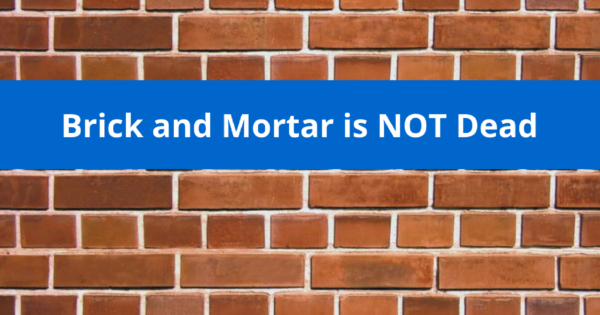Is the internet stealing customers away from you? Are you ready to give up and concede that brick and mortar is basically done?
Relax – brick and mortar is not dead, you may just need to make a few adjustments to your strategy.
[xyz-ihs snippet=”TOFU2-Retail-Technology-button”]
The Reality of Online Shopping
Yes, more people are turning to the World Wide Web for shopping and that’s not likely to change any time soon.
In 2010 there were 172.3 million online shoppers in the US. In 2013, those numbers rose to 191.1 million, with a projected 215.1 million by 2018, according to Statista.com.
There’s no way you can stop internet sales from growing at an amazing rate, but fear not, local retail business is still open for business.
The Case for Brick and Mortar Retail Sales
 Recent studies show that people still enjoy shopping locally, especially for apparel. Here are five good reasons why:
Recent studies show that people still enjoy shopping locally, especially for apparel. Here are five good reasons why:
1) There’s No Substitute for Personal Service
Online shopping can be a cold and impersonal experience and most retail websites and apps don’t have well-integrated customer service. Even when they do, it’s no substitute for a personalized touch.
Local customers have associates to communicate with and in some cases – when there are repeated interactions – forge relationships with.
2) Browsers are More Likely to Become Customers
Did you know when someone uses a fitting room they are far more likely to buy? It’s true. A 2013 City Accenture study showed that fitting room users are 70% more likely to make a purchase. When shopping online, there’s no physical fitting room available – and the virtual ones that do exist are poor imitations of the try-on experience.
In addition, 88% of consumers have checked out online retailers before buying locally. This is a practice known as webrooming, and it’s something brick and mortar stores can and should take advantage of.
3) Local Shopping is Faster
After paying for their purchase the online shopper to wait for processing and shipping, which can take days or even weeks.
Local shopping provides the instant gratification of having the purchase in hand at the end of the transaction.
4) Consider Local vs Online Shopping Statistics
Graphs.net published some stats on offline vs online shopping, some of which are very interesting for store owners.
Here’s a sample:
- Not everyone is turning to the World Wide Web. In fact, only 55% prefer online shopping.
- 71% of women and 53% of men research online before they buy locally, and those people spend an average of 33% more when shopping.
- The vast majority of consumers have not visited a fashion retailer’s Twitter, Facebook, or mobile website (90%).
[Tweet “90% of consumers haven’t visited a fashion retailer’s website or social accounts”]
- More than half (51%) of local shoppers want their products now, and that is why they forgo the Internet (Forrester Research).
- 42% of consumers want to see and feel their products before buying.
- Consumers are willing to pay as much as 50% more for the privilege of personally examining their items beforehand (Caltech).
- Cross-channel commerce is expected to be 5 times that of E-commerce in the near future.
5) Local Purchases = Fewer Returns
Local shopping means fewer returns and refunds:
- Pictures can lie – That new sweater looked perfect online, but in real life the material might be scratchy or itchy, or hang funny. The disappointed shopper will want their money back.
- Fit – Have you ever bought a shirt, pants, dress, or other item online and when it arrived it didn’t fit? That can be so frustrating and is one of the main problems with online shopping for apparel.
- The Decision Has Been Made – When a shopper has the chance to try something on and see how it fits, they have an opportunity to make a decision about that purchase, and there is a much smaller chance they’ll be going back for a refund or exchange.
[Tweet “Brick and Mortar #Retail Sales are NOT Dead”]
How to Increase In-Store Sales
At this point, you may be thinking, “This sounds good, but how can I get more customers into my store?”
The answer to that is a long-term strategy: Solve the Customer’s Problems!
When a customer has a problem, so do you, and if it’s not resolved, the customer may walk out the door, never to return. Think of what type of problems your customers might encounter based on past experience, and then come up with a viable solution.
Here’s an example:
Problem: How many times have you tried on several items and then finally gave up and walked out? There may have been more selections available, but it was too much trouble to re-dress and go back out in the store. When this happens to your customers, you lose their business.
Solution: Give customers a way to summon help from inside the dressing room. There is no need to re-dress in order to try on more clothing items.
You may have a number of other problems you know your customers have that are unique to your location or buyers. It’s worth taking some time to do an inventory and see if you can uncover other solutions.
[xyz-ihs snippet=”TOFU2-Retail-Technology-button”]
Conclusion
As you can see, reports on the demise of brick and mortar have been somewhat exaggerated, and here are good reasons to be optimistic:
- You offer personal services not available online.
- People can see and feel your products before they buy.
- You provide products to customers without waiting for shipping.
- Your customers have someone knowledgeable to turn to for advice.
- Solving customer problems will increase your business.
Brick and mortar businesses are as alive and thriving as ever!
[xyz-ihs snippet=”Try-It-On-CTA”]
